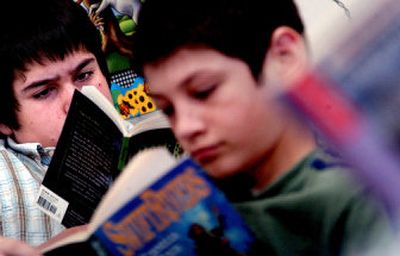Grant will fund reading initiatives

The Lake Pend Oreille School District wants to see at least nine of every 10 of its students reading proficiently by 2009.
And the district has $437,000 in grant money to fund the journey to that goal.
Starting in the fall, teachers will begin using research-based strategies to help students improve their reading. This is a kindergarten-12th grade effort that district leaders hope will lead to systemic and lasting changes for their schools.
The grant came from the Panhandle Alliance for Education, a Sandpoint nonprofit organization that gives financial support to schools.
In the past, that has come in the form of teacher grants. But early in 2005 the organization set out to find a long-term project to fund that would have enduring effects.
“They said: We want it to be a difference-maker,” said Superintendent Mark Berryhill.
They considered a program to enrich students in the upper quartile, a preschool program and a reading program, before ultimately deciding on the latter.
For Berryhill and others, it was the right choice. “This will make a huge difference in our district and it will be measurable,” he said.
Though the impetus was not the federal No Child Left Behind Act, the program should help improve standardized test scores as well, Berryhill said.
The funds will be used primarily to professionally train teachers. The district contracted those services from the Consortium on Reading Excellence, a Berkeley, Calif.-based company that has worked with more than 1,000 schools and 70 districts, including those in Caldwell, Idaho, and Yakima, Wash.
CORE uses teaching practices that were identified by a national panel in the 1990s as the most effective for teaching students to read.
That panel tracked students for a year to glean the most effective strategies and tested them in blind studies at schools across the nation.
The method focuses on phoneme awareness (the understanding of speech sounds), phonics (the sounds and spellings), decoding (using things like roots, suffixes and prefixes to figure out the meaning of a word) and vocabulary.
Those are the building blocks of reading, said Jeannie Lyon, a language arts teacher at Sandpoint Middle School. When those are in place, students read faster and understand more, added Lyon, who has received training and will help coach fellow teachers.
Even after the grant ends in four years, the district will still invest in training by sending teachers to the annual CORE summit so they can stay current on teaching research and strategies, Berryhill said.
Students across the district are being screened to assess their reading level and to provide starting points for the district’s database that will track progress, said Judy Hull, the Title I director and coordinator for the grant.
“It’s important to see where we are today and we know where we want to be,” Hull said. The district can use the data to make adjustments along the way and see what needs to be done next, she added.
CORE divides students into four groups, which district officials compared to swimming abilities:
“ Intensive: Students who are drowning. They are below the 25th percentile.
“ Strategic: Students who are treading water but are struggling in classes that require a lot of reading. They are in the 25-49th percentile.
“ Benchmark: Students who are swimming. They are in the 50-79th percentile.
“ Advanced: Students who are on the swim team. They are in the 80th percentile.
For the first year, teachers will focus on the students who have the greatest difficulty reading. They will be in separate classes so that they can receive extra attention and work on their skills without fear of teasing, since they’re all at the same level, said Lyon, the language arts teacher.
The year after that students in the next level will start receiving specialized instruction. Then students in the upper levels will be challenged to continue to improve their reading, said librarian Julie Smith.
“It really should do the trick,” Smith said.
But she cautioned that the results won’t be visible overnight. The students who struggle the most should be up to speed in three or four years, she said. The students in the level above that should read at grade level in about a year.
Still, it’s worth the sustained effort, Smith said. In the early years students learn to read. After that they read to learn.
“If you cannot do that, you become further and further behind in all aspects of school,” Smith said.
“Reading is the basis of anything they’re doing to study.”